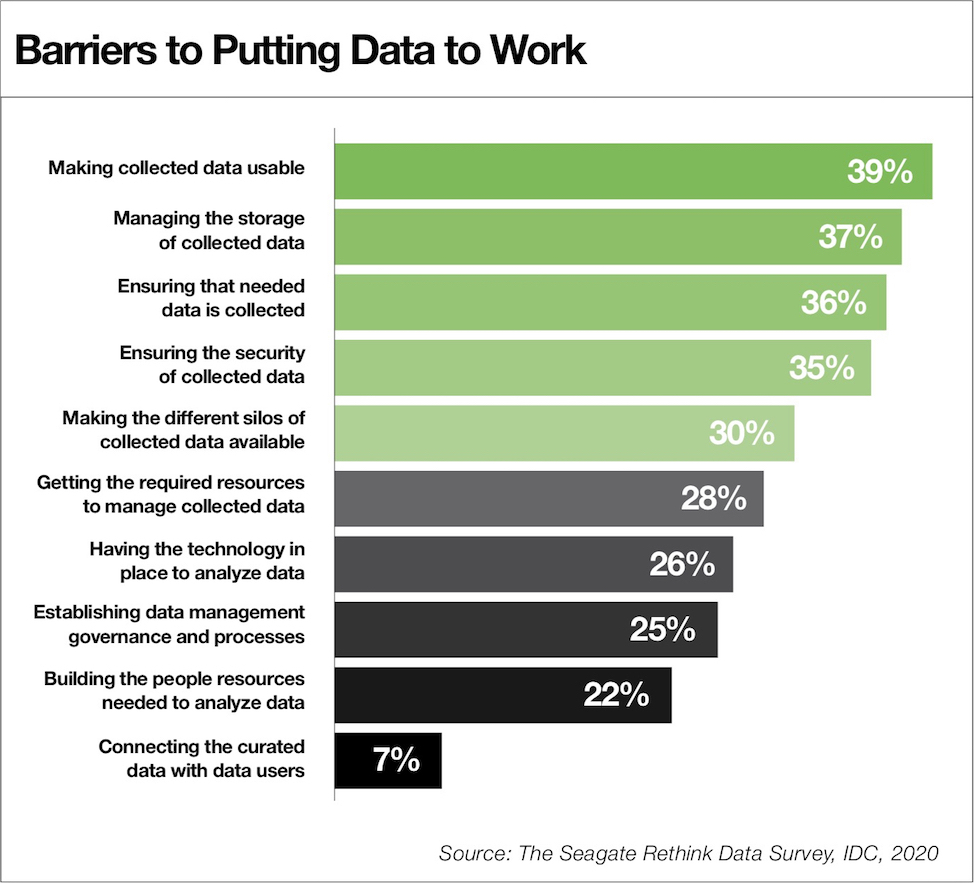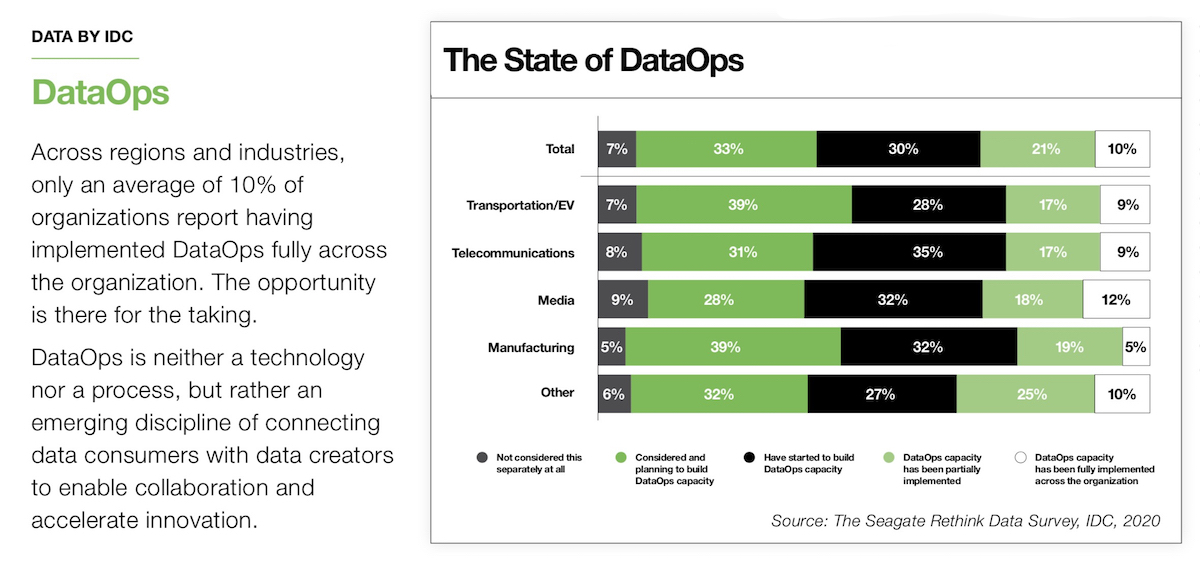Don’t (Merely) Hoard Data — Put It to Work
Business leaders and data managers are in a race to keep up with today’s unprecedented data growth and data sprawl. To find and leverage the value in the continuous data torrent flowing across networks between data centers, multicloud platforms, and the edge requires a more dynamic approach to managing the movement of data.
The complexity of data architectures and data locations compounds these challenges.
Now, a new report by Seagate, Rethink Data: Put More of Your Business Data to Work — From Edge to Cloud, discusses why companies must find new ways to gain business value from a plethora of data being generated from the edge to the cloud. The report draws on research conducted by IDC, and is based on a survey of 1,500 IT executives from around the world. You can read the full report here.
The good news is that there is a solution to today’s data management dilemmas: DataOps — a discipline of connecting data creators with data consumers. Business leaders who opt to implement DataOps can count on better business outcomes, such as increased customer satisfaction and higher profits.
The Rethink Data report underscores why DataOps is essential for data management, why companies need to get a better handle on “data in motion” and the processes supporting AI and data analysis, and how multicloud platforms are becoming the new normal for many enterprises.
DataOps: The Missing Link of Data Management
The report’s bottom line: Enterprises of all sizes need a more integrated approach to data management. DataOps — an emerging discipline designed to improve the speed, quality and value of data analytics — is the missing link. Businesses can, for example, apply the DataOps model to the iterative learning process that artificial intelligence (AI) applications require. This differs from a traditional data analytics approach. Instead of searching for an answer to a specific problem, DataOps makes data associations and searches for insights. Using a DataOps philosophy, enterprises take a more holistic view of their data.
A majority of IT leaders surveyed by IDC for the report said that DataOps is “very” or “extremely” important to their organization. However, only 10% reported that their companies have fully implemented a DataOps solution.
Implementing DataOps requires that data consumers — business owners and line-of-business leaders — seek a clear understanding of how and where data is gaining in volume, and what data should be collected from myriad sources, from endpoints and IoT devices to the people who generate reports and information that is fed to decision-makers. Improving data flow and analytics can increase productivity and speed up the innovation process.
A DataOps approach can help businesses manage data from multiple parts of an enterprise more effectively. “Being able to correlate data from disparate sources is a capability not easily available through other means,” the report notes. “Because it is difficult, those organizations able to master it can expect to have an edge over the competition.”
In addition, a DataOps strategy would use machine learning to automate the process of aggregating and analyzing data from multiple sources such as core, cloud and edge devices. Machine learning models can learn from the data itself, becoming more precise over time. Using machine learning enables enterprises to gain insights from data that might otherwise be overlooked by a human analyst.
DataOps can, for example, provide retailers with insights about why shoppers purchase unrelated items. Armed with that information, retailers can improve marketing strategies to target more interested customers, adjust merchandising mixes and refine product placement to increase sales where there is demand.
Manufacturers can apply the DataOps discipline to collect and analyze data on the performance of machines so they can improve maintenance efficiency and uptime. Machine learning also enables an enterprise to more intelligently scale its ingestion of data flowing in from thousands of IoT devices located throughout a production facility or distribution center.
68% of Data Goes Unused — A Devastating Loss of Value

According to the report, 68% of the data available to enterprises goes unused, and failing to analyze data in today’s economy means leaving money on the table. AI-driven automation can help companies access and put to use data scattered at the edge, in the cloud and in data centers. Companies that use AI as part of a DataOps approach to analytics can increase their ROI from improved productivity and new business insights.
Organizations face five key challenges that they believe limit their ability to exploit the full potential of collected data:
- Making collected data usable
- Managing the storage of collected data
- Ensuring that needed data is collected
- Ensuring the security of collected data
- Making the different silos of collected data available
These considerations should matter to business owners because they directly affect the value of data that businesses can uncover, which affects revenue.Better management of siloed data from multiple sources can translate into business growth. Business leaders surveyed in the Rethink Data report say they only use 32% of the data available to them. That means a lot of data is wasted. “Every business is a data business,” says Naik. “But enterprise data is of little value if it is not used.”
Data management solutions should focus on resolving these challenges to provide the most effective experience possible for both business owners and customers, and begin to help businesses chip away at the percentage of data that they are unable to exploit.
“The findings of this study illustrating that more than two-thirds of available data lies fallow in organizations may seem like disturbing news,” said Phil Goodwin, research director at IDC and principal analyst on the research survey. “But in truth, it shows how much opportunity and potential organizations already have at their fingertips. Organizations that can harness the value of their data wherever it resides — core, cloud or edge — can generate significant competitive advantage in the marketplace.”
 “The more pieces you put together, the bigger a puzzle you can solve,” says Ravi Naik, Seagate Chief Information Officer and Senior Vice President, Corporate Strategy. “You can tackle a much higher-order problem if you share data, cross-referencing various streams of information for analysis.”
“The more pieces you put together, the bigger a puzzle you can solve,” says Ravi Naik, Seagate Chief Information Officer and Senior Vice President, Corporate Strategy. “You can tackle a much higher-order problem if you share data, cross-referencing various streams of information for analysis.”
Machine learning helps companies analyze data in real time to determine what is valuable and what is superfluous. AI-driven processes, such auto-pruning, can automatically archive data that is not immediately needed.
Ultimately, machine learning helps businesses gain more value from their data. Grocery stores, for example, collect data on product sales that helps them determine inventory mixes. In healthcare, hospitals can track patient volume to estimate costs in order to more efficiently predict and manage budgets.
Managing Data in Motion
Enterprises must manage the flow of data in motion as it travels between edge locations, core data centers, and the cloud. The report addresses many hurdles and offers analysis of several key elements needed to overcome them.
The amount of data stored at the edge — which processes data closer to the source and can accelerate analysis — is growing at a faster rate than data stored in the core; this trend expands data sprawl. Enterprises will have an ever-increasing need to manage this scattered data wherever it exists.
According to the report, companies now transfer about 36% of data from edge locations to their core data centers. But the report also underscores that most businesses are failing to take advantage of data scattered at the edge — whether from production lines, smartphones, autonomous vehicles, or other connected devices.
The more data can move, the easier it is for business leaders to make key decisions. AI-driven automation can help rapidly process data from multiple sources. “Data needs to move in order to allow for interconnectedness of data — and the insights that result,” Naik says.
Orchestration of containers and recovery processes can help companies manage data in motion. Data orchestration takes data from multiple storage platforms and makes it available to applications via APIs. According to IDC numbers in the report, 45% of midsize to large enterprises already use orchestration to deploy multiple apps companywide.
Another tool for streamlining data management is virtualization, which creates a virtual instance of an operating system, server, or storage device. This provides an efficient way to aggregate and manage data in a unified environment.
Improved security and encryption protocols are also essential for improving management of data in motion. In fact, two-thirds of the survey respondents indicated they had insufficient data security in their organizations.
The report outlines the roles these elements may play in a DataOps strategy and the paths enterprises must consider to reap their benefits.
Managing Cloud Complexity
According to the Rethink Data report, managing data in multicloud environments is the number one data management challenge for enterprise users. Managing hybrid clouds is the second-biggest issue reported by IT leaders.

A multicloud environment consists of data storage in multiple public clouds or a combination of public and private clouds. A hybrid cloud fuses the resources of two or more different clouds (whether they are all public, all private, or private and public clouds).
One of the hurdles for businesses running hybrid clouds is connecting legacy data center networks with public clouds. IT managers also need to develop a cohesive long-term integration plan for multiple clouds. Many enterprises encounter data management problems when their infrastructure is proprietary or designed for a single cloud. Different cloud platforms have separate workflows and management tools, and lack unified security management protocols.
“Multicloud deployments are much more difficult to orchestrate and manage consistently, as the infrastructure tools native to each cloud platform are typically designed to operate within the confines of the specific platform,” says Andrew Smith, research manager at IDC.
The report goes into detail about the benefits and challenges presented by various cloud models, and why it’s often beneficial to deploy across multicloud. It also offers advice on how business leaders can work with IT leaders and data managers to create a multicloud strategy that works. Ultimately the key goal is to deploy a strategy and architecture that lets business leaders see their stored data — all of it — as if through a single pane of glass.
In other words, CIOs should be able to look across multiple cloud ecosystems in a seamless manner.
The Value of Rethinking Data
Data management is both challenging and rewarding. But one thing is certain: Enterprises need to get a better handle on their data. IDC reported that by 2025 the rate of data created will increase exponentially, to 175 zettabytes. “At zettabyte scale, there needs to be a simple, secure, and economic way to capture, store, and activate data,” says Dave Mosley, CEO of Seagate.

DataOps is essential for improving data management as well as for harnessing and managing information from multiple sources. Effective management and orchestration are critical for realizing value from previously underutilized data.
The IDC survey in the Rethink Data report found that better data analysis leads to measurably better business outcomes.
For most organizations, the trifecta of better business outcomes is the following:
- Better revenue.
- Better profit.
- Better customer satisfaction/loyalty.
But better results due to data management and analytics were seen across the enterprise and also included:
- Better employee productivity.
- Better employee retention.
- Lower costs.
- Improved regulatory compliance.
- Better new customer acquisition.
Among the more proactive results is better new customer acquisition, which obviously is the key to growing revenue.
The challenge is how to deploy DataOps to interconnect data in motion, enable a real-time aggregated view of all data, and address governance and security issues.
Improving data governance will ultimately yield more actionable insights that increase productivity and outcomes. Ultimately, that translates into a better ROI.
As the IDC report notes: “Getting to data faster means customers and business owners can make decisions faster.”
Dig into the details; download the full report: Rethink Data: Put More of Your Business Data to Work—From Edge to Cloud.
